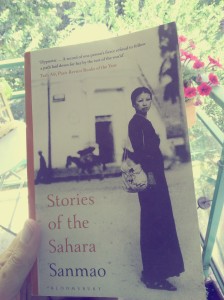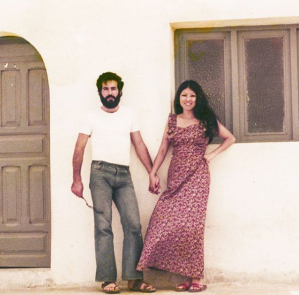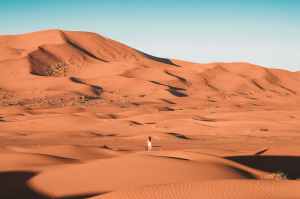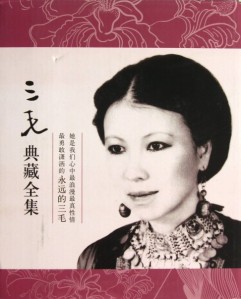translated (from Chinese) by Mike Fu.
Literature Worthy of Translation
 Usually when I come across a new book that sounds like my kind of read, meaning it is of cross-cultural interest, where a character (or person) from one culture (preferably not one I’m familiar with) encounters another, I’ll find others who’ve read it to discern whether it’s for me or not.
Usually when I come across a new book that sounds like my kind of read, meaning it is of cross-cultural interest, where a character (or person) from one culture (preferably not one I’m familiar with) encounters another, I’ll find others who’ve read it to discern whether it’s for me or not.
As soon as I saw the cover of Stories From the Sahara, I was intrigued. A fascinating and popular Taiwanese woman author of many books and essays, living in the Sahara with her Spanish lover; why has only one person I follow read this and why are we only hearing about this mysterious travel writer in 2020?
I don’t know the answer to my question (I suspect publisher’s had their radar tuned elsewhere in the past and perhaps the Anglosphere/Sinosphere head butting that takes place in the political arena affected their vision); but August is WIT (Women in Translation) month, a movement that’s gaining traction and interest, the genre and languages of books translated/published is widening and thanks to Eleanor at The Monthly Booking I bought this engaging and unforgettable read.
Thanks Mike Fu, who read the book as a young man and has translated it into English, he is now translating her next book, of their adventures in the Canary Islands.
Who is Sanmao? Echo Chen? Chen Ping?

Sanmao & José, Al Aaiun, Sahara
In 1973, an independent young Chinese woman, born Chen Ping on 26 March 1943 left her family home in Taiwan, after a family tragedy, to travel to the Spanish Sahara with her friend José. They married in 1974. She had first lived in Spain in 1967 attending university in Madrid.
While in the Sahara she was inspired to write vignettes of her life there, they were published in Taiwan and China to great acclaim. The first volume debuted in May 1976.
Sanmao published more than twenty books, mostly semi-autobiographical essays, selling over fifteen million copies.
In a beautiful, moving essay, commemorating what would have been Sanmao’s 77th year, her niece Jessica Chen, remembers her Auntie, sharing something of the unique soul she was and the words of her grandparents, speaking of their tender, beloved daughter who, “had simply gotten off the train of life sooner than we expected”.
Grandpa and Grandma always said she was a special child with a gift from God, and the richness of her interior life was off-limits to others—unless she chose to let you in herself. Writing was the window she opened to the outside world. The people who understood this would naturally discover a path to her heart; those who didn’t could only stand at the window and gaze in from afar.
What was Sanmao doing in the Sahara?

Photo by Taryn Elliott on Pexels.com
One day Sanmao was absent-mindedly flipping through the pages of National Geographic when she came across a feature on the Sahara. It was from that moment that she developed an obsession not just to visit, but to live there.
I only read it through once. I couldn’t understand the feeling of homesickness that I had, inexplicable and yet so decisive, towards that vast and unfamiliar land, as if echoing from a past life.
Arriving in Spain, she learned that 280,000 square metres of the Sahara at the time were designated Spanish territory. Her desire to go there deepened, torturing her with longing.
José went ahead of her, securing a job at a phosphate mine, found them a home, allowing her to fulfill that soul-whispered desire.
Book Review – Stories of the Sahara
 I absolutely loved Stories of the Sahara, in its entirety and it will likely be my favourite nonfiction title of the year. It is so refreshing to read a travelogue by a woman from another culture and discover a writer beloved of Chinese and Taiwanese readers for decades.
I absolutely loved Stories of the Sahara, in its entirety and it will likely be my favourite nonfiction title of the year. It is so refreshing to read a travelogue by a woman from another culture and discover a writer beloved of Chinese and Taiwanese readers for decades.
I almost couldn’t get over how tough it was during that initial period and thought often about heading back to Europe. Amid that endless stretch of sand, it was so hot during the day that water could scald your hands, while night was so cold that you had to wear a heavy coat. Many times I asked myself why I insisted on staying here. Why had I wanted to come to this long-forgotten corner of the world all by myself? As there were no answers to these questions, I continued to settle in, one day at a time.
I hadn’t expected it to be so funny, so many of her observations and the things requested of her made me laugh out loud. It’s unlike any other travel memoir I’ve read; here is a sensitive, empathetic woman, bringing a completely fresh set of eyes, to a place few of us will ever have dreamed of living.
At her first glimpse of the periphery of Al Aaiún, as they walk from the airport towards her new home, she is in awe seeing tents, bungalows, camels and herds of goats in the sand.
It was like walking into a fantasy, a whole new world.
The wind carried aloft the laughter of little girls playing a game. An indescribable vitality and joy can be found wherever humans exist. Even this barren and impoverished backwater was teeming with life, not a struggle for survival. For the residents of the desert, their births and deaths and everything in between were all part of a natural order. Looking out at the smoke ascending to the sky from their homes, I felt that these people were almost elegant in their serenity. Living carefree, in my understanding, is what a civilised spirit is all about.
 The combination of her naivete, determination and feminism – her refusal to be stopped from doing what she wants – create some of the most hilarious and alarming moments. Her kindness and frankness gain her entry inside the culture and landscape, providing insights few are capable of accessing. People trusted her – yes they often took advantage of her – but she was a willing participant. They provided rich literary material, clearly!
The combination of her naivete, determination and feminism – her refusal to be stopped from doing what she wants – create some of the most hilarious and alarming moments. Her kindness and frankness gain her entry inside the culture and landscape, providing insights few are capable of accessing. People trusted her – yes they often took advantage of her – but she was a willing participant. They provided rich literary material, clearly!
This is one of those books I don’t wish to share much of what is inside, I prefer to say, “Read this, it’s so good!”
I was intrigued by the obsession she had to go and live in the Sahara, I was delighted that she lived at the wrong end of the street in among the permanent locals, I loved her sense of adventure, how she overcame boredom in searing heat, getting in the car and driving for hours in the desert. But it is her frankness, her empathy and sense of humour that make it an unforgettable read.
Reading Women in Translation
I picked this up to read for #WITMonth and it’s one of the best, that combination of travel to a new place, meeting local people through the perception of someone from a culture other than our own, priceless.
“Travel with an open heart, then bring back home the feelings that you find.” Sanmao
Further Reading
Colombia University: Interview with translator: Mike Fu
Words Without Borders, Essay by Jessica Chen (niece) March 2020: Sanmao’s Footprints: Remembering the Writer on Her 77th Birthday
New York Times Obituary: Overlooked No More: Sanmao, ‘Wandering Writer’ Who Found Her Voice in the Desert

Hi Claire
Thanks for this review. It certainly sounds like a book I’d like to read and I hope I can order it in NZ .
LikeLiked by 1 person
Well, you’ve certainly sold this to me. I want to read it! Sourcing it may be the next problem…
LikeLiked by 1 person
This was a must read as soon as I heard of it, fortunately it was already out in paperback, because I didn’t want to wait. Its a Bloomsbury publication so it should be widely available.
LikeLiked by 1 person
I haven’t been able to track it as a paperback, but – result! I’ve just reserved it from my local library service!
LikeLiked by 1 person
Thank you very much for this. I bought the book a few weeks ago on another friend’s recommendation and earmarked it for a holiday read next week. I’m looking forward to it even more – I can’t resist anything about travel in deserts!
LikeLike
Perfect choice for a holiday read, and I agree, there is something alluring about travel in the desert.
LikeLike
Lovely read
Stay safe happy healthy and wealthy
LikeLiked by 1 person
Thanks, one of the best reads of 2020 and perfect travel escapism for these troubled times.
LikeLike
Thank you so much for this – I’ve never heard of it, but it sounds absolutely fascinating, as does its author! What a find!
LikeLike
I am intrigued by this author and her story, Claire. Thank you so much for bringing it under my attention. There are so many wonderful books in the world that we miss out on, because they have not been translated.
LikeLike
Oh this sounds just my cup of tea, I love a cross-cultural read. AND I thought she and her name looked familiar and it turns out we stayed really near to where she lived on Gran Canaria in early March – there was a big mural and some text about her and apparently the place attracts a lot of Chinese tourists!
LikeLiked by 1 person
Oh wow, that’s so serendipitous that you’ve come across her name. Her second book which is being translated will tell of their adventures in the Canary Islands, I wish they’d had more time together, it’s a sad story. I do hope you get to read her Stories in the Sahara and learn more about this adventurous spirit.
LikeLiked by 1 person
Oh, I’m glad they’re translating the Canary Islands one as I will definitely get that, too. it’s funny, we were staying in a really quiet residential suburb rather than a tourist area (thus avoiding catching Covid-19, at least) so there was such a small chance one of your readers had seen that monument AND your post about the book!
LikeLiked by 1 person
That really is an uncanny coincidence, when I learned that the translators is working on the second book, I couldn’t help noticing that the Canary Islands are so close to the Sahara and given that the period her stories from the Sahara are set in, it was referred to as the ‘Spanish Sahara’, the wider historical context becomes interesting and thought provoking as well.
LikeLiked by 1 person
This sounds fascinating Claire. What a life! I can’t imagine living in the Sahara – I get grumpy at anything over 30C. Thank you for introducing me to this author.
LikeLiked by 1 person
I know what you mean and then when you read it, you realise the desire is so genuine, she really was an extraordinary and adventurous woman and her personality shines big in her stories, just delightful, but the Sahara – really – this is truly a voyage you want to do from the armchair!
LikeLiked by 1 person
Pingback: Best Reads of 2020 – Word by Word
I can’t believe it! I’m reading a post about the books by 三毛 (pronounced ‘Sam Mo’ in Cantonese), as I’d known her name to be. As young teenagers in Hong Kong (then British Colony), my school mates were crazy about her writings, so romantic and adventurous. I wasn’t as crazy as they were, keeping my mind rational and thoughts realistic, but I was touched by her free spirit. So it’s just wonderful to hear her books have been translated into English… better late than never. As teenage girls, we had several ‘must-read’ authors, 三毛 was one of them.
LikeLiked by 1 person
Oh wow, finally I’ve come across someone who has heard of her writings, clearly they were very popular in her day, she is such a great character, an intriguing, unorthodox young woman. I just loved reading views and insights by a traveller from a non English speaking culture, it was such a refreshing perspective.
LikeLike
Well, if you ask any immigrant from Hong Kong / Taiwan, let’s say 50 years of age and over, they would probably have heard of her and read her books. We read it in its original language, Traditional Chinese, which is even better. 🙂
LikeLiked by 1 person
I do have a friend here who was in Hong Kong back then, and she’s a reader, I’m going to ask her! Oh to read it in the original would be amazing. I did wonder whether she felt even more free with her words knowing they wouldn’t or couldn’t be read by anyone around her, especially her mother in law, who gets a bit if bad wrap, though not hard to imagine how she would have been disapproved of, I’ve heard similar tales of French mother in law’s here. 🙂
LikeLike
I’m sure she’d never had expected her books would be translated now decades later in the 21st C. And, I must check out this translator, Fu and her niece? What’s her name again and is she a writer herself?
LikeLike
Mike Fu, he’s on twitter @tragicsalad
I’m not sure about the niece.
LikeLike
Nice chatting with you on Sam Mo. Keep up the good work on this blog, Claire, and all the best for 2021!
LikeLiked by 1 person